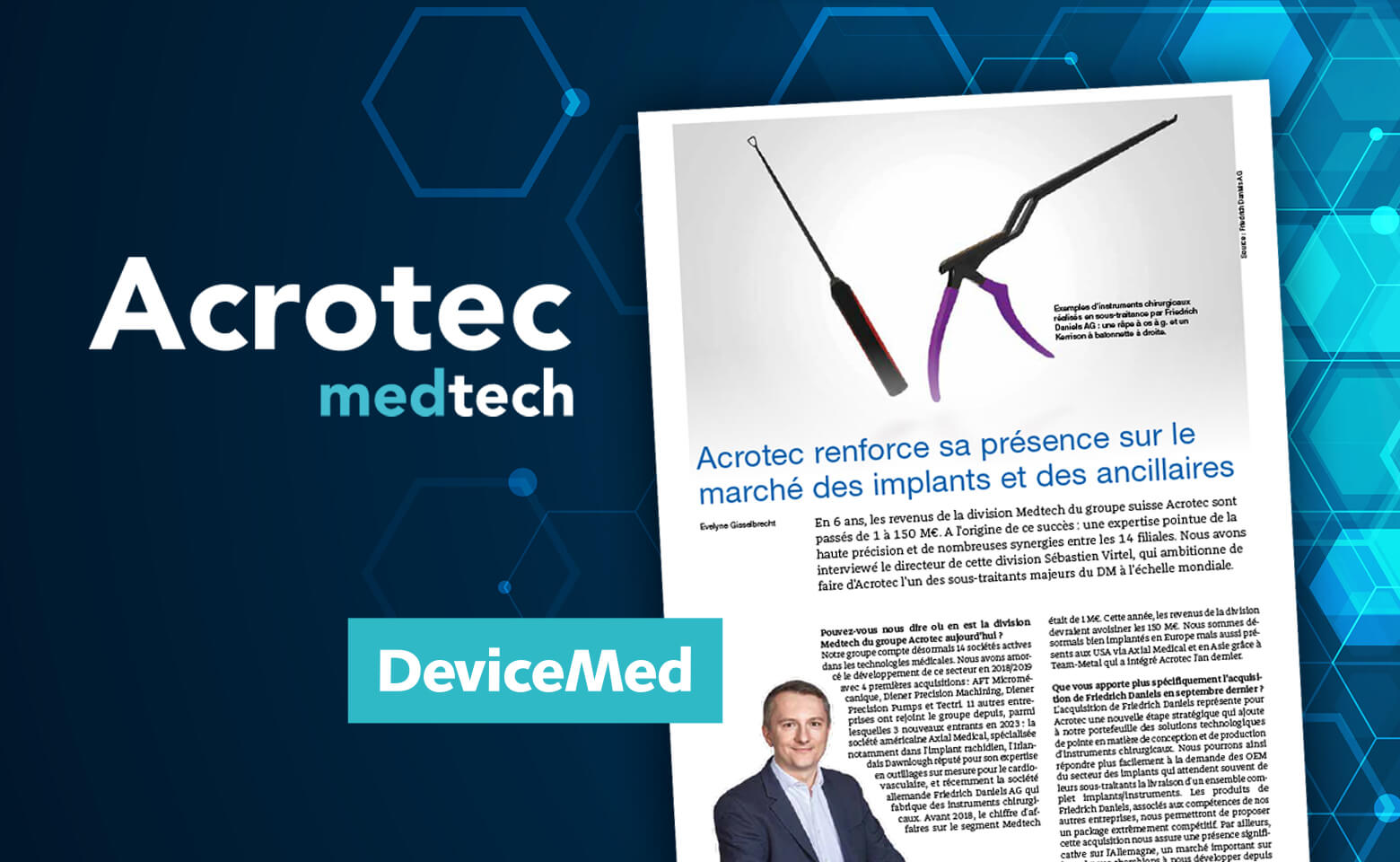In 6 years, revenues for the Medtech division of Swiss group Acrotec have risen from €1 million to €150 million. The key to this success lies in the group’s high-precision expertise and the numerous synergies between its 14 subsidiaries. Devicemed has interviewed the division’s director, Sébastien Virtel, whose ambition is to make Acrotec one of the world’s leading DM subcontractors.
Can you tell us where the Acrotec Group’s Medtech division stands today?
Our Group now has 14 companies active in medical technologies. We initiated the development of this sector in 2018/2019 with 4 initial acquisitions: AFT Micromécanique, Diener AG Precision Machining, Diener Precision Pumps and Tectri. 11 other companies have since joined the Group, including 3 new entrants in 2023: the American company Axial Medical, specializing in spinal implants, the Irish company Dawnlough, renowned for its expertise in custom tooling for the cardiovascular sector, and recently the German company Friedrich Daniels AG, which manufactures surgical instruments. Prior to 2018, sales in the Medtech segment were €1m. This year, the division’s revenues are expected to approach €150m. We are now well established in Europe, but also present in the USA via Axial Medical and in Asia thanks to Team-Metal, which integrated Acrotec last year.
More specifically, how did the acquisition of Friedrich Daniels last September benefit you?
The acquisition of Friedrich Daniels represents a further strategic step for Acrotec, adding leading-edge technological solutions for the design and production of surgical instruments to our portfolio. This will enable us to respond more easily to demand from OEMs in the implant sector, who often expect their subcontractors to deliver a complete implant/instrument package. Friedrich Daniels’ products, combined with the skills of our other companies, will enable us to offer an extremely competitive package. In addition, this acquisition gives us a significant presence in Germany, an important market in which we have been seeking to expand for several years now, and which is not easy to penetrate. Last but not least, Friedrich Daniels works with all the major American manufacturers, which will contribute to Acrotec’s continued development in the United States, especially as numerous synergies can already be envisaged with Axial Medical.
Have the new entrants enabled you to broaden your range of services?
That’s for sure. By way of example, Team-Metal is particularly efficient in the production of complex, high-precision parts in small runs. In Europe, our companies tend to automate production as much as possible, which makes the manufacture of small volumes rather complicated. This has enabled us to strengthen our presence in this niche. Axial Medical in the USA, on the other hand, is able to supply large volumes thanks to a highly automated plant, which enables it to produce at cost levels that are hard to match.
Given the size of the market, it can even dedicate certain machines almost year-round to certain product references. On the technical front, Axial Medical has succeeded in automating the milling of highly complex anatomical plates, which require cycle times of several hours (see photo opposite). Here too, the sheer size of the market makes this possible. Friedrich Daniels AG, for its part, relies on the network of blacksmiths in the Solingen cutlery cluster south of Düsseldorf, and has perfect mastery of this technology, as well as of all the downstream manufacturing processes it implements in-house, whether machining, wire cutting, sinking or laser marking. This diversity of processes is quite unique within a single company.
Could you give me some examples of synergies between companies in the Medtech division?
I’m thinking in particular of a motorized bone surgery instrument intended for one of the biggest OEMs on the market. The project leader is AFT Micromécanique, which subcontracts 50% of the 30 or so components for this instrument to six other Group companies. We are also working on a stenting system for the neurological field. This is a micro-piece on which several companies will be involved: Tectri for bar turning, Microweld for cutting and welding, all using tooling designed and produced by Dawnlough, the customer having been introduced by Takumi. This is one of our biggest projects to date. It illustrates the benefits of this collaboration between our different companies.
What about coordinating these projects?
In view of the ever-increasing number of projects involving several Group companies, and the broad scope of our subsidiaries’ operations, we have set up a team whose role is to ensure the fine coordination of these projects. I am supported here by a Senior Project Manager and a Project Coordinator, both former Johnson & Johnson employees. It’s essential to relieve our companies of this coordination work. We have also set up a CRM (customer relationship management software) which enables us to direct requests to the companies best suited to meet them. In this way, we encourage companies to consult each other in a transparent manner, and try to determine which one is best placed, has the most available capacity, or the least investment to make. This is done in a spirit of mutual understanding, especially as all the managers of our subsidiaries are shareholders in the Group. So they all have a stake in our shared success. It’s worth noting that we systematically invite the CEOs of the Medtech division to visit new entrants. This enables the companies to discuss their production and management methods, and to get to know each other better, with a view to developing collaborations. Our structure is decentralized, rather like a federation. Our subsidiaries retain their decision-making powers and their own teams.
Can you measure the benefits of belonging to a group at company level?
We asked ourselves this question in order to be able to pass on factual data to our customers and to companies likely to join us. Over the period 2023-2028, half the projects on which our subsidiaries are working are the result of collaboration within the Group. In other words, on average, this will enable them to double their development! Even if they don’t all benefit in the same way, depending on the nature of their business, belonging to Acrotec opens up new markets and new customers, who are increasingly attracted by the wide range of services we offer and the responsiveness of our companies.
What is Acrotec Medtech’s future external growth strategy?
We are currently seeking to strengthen our presence in markets such as cardiovascular, which require very small, extremely complex parts, generally produced in large quantities, for single-use applications. We are also looking to expand into the field of robotic surgery. As far as implants and instruments are concerned, for example, we are still lacking in packaging and transport baskets for the operating room. It is essential for us to find new companies whose activities are different from those of our own, but with whom synergies are possible – the main condition being, of course, that they share our values and corporate culture. Finally, in geographical terms, our priority is clearly the US market, but also Asia, where we would like to acquire a second company. Medical technologies should eventually account for 40% of the Acrotec Group’s sales, and our aim is to achieve revenues of €400 million within 5 to 6 years, which would place us among the world’s top 5 medtech subcontractors in the markets in which we operate.
To read the full article (in french only), click here.


